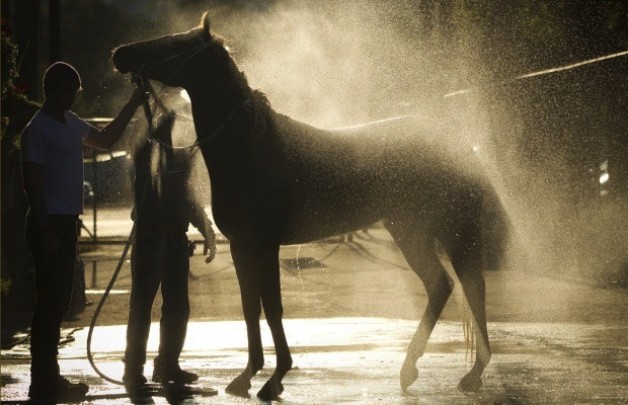It’s getting into the hottest days of summer. Here’s a quick heat-stress reference that’ll help you know when your horse is overheated–and what to do to help him chill.
By Barb Crabbe, DVM
It’s as hot as a tin roof, and you’ve got a day-long trail ride ahead. How can you tell if your horse gets too hot? In the July 2006 issue of Horse & Rider magazine we shared warning signs you should never ignore.
We’ll add to that list with these six heat-stress signposts you should never ignore, and offer tips for cooling your horse quickly.
Heat-Stress Signposts
Signpost 1: Elevated Respiratory Rate
- Why it happens: Hard breathing forces air to flow past vessels in your horse’s lungs and airways, which helps cool his blood.
- Risky: When your horse’s respiratory rate is more than 40 to 50 breaths per minute, and/or he’s breathing shallowly, and his breathing doesn’t return to normal after two minutes’ rest.
Signpost 2: Elevated Heart Rate
- Why it happens: A pounding heart transfers blood to your horse’s skin surfaces to be cooled by outside air.
- Risky: When his heartrate is more than 80 beats per minute, which doesn’t start to slow down after two minutes’ rest.
- Find out how to check your horse’s heart rate.
Signpost 3: Profuse Sweating
- Why it happens: Evaporation of sweat from your horse’s skin helps him cool down.
- Risky: When he’s sweating over his entire body or worse, he stops sweating entirely.
Signpost 4: Elevated Temperature
- Why it happens: Your horse’s cooling mechanisms have been overwhelmed.
- Risky: When his rectal temperature goes up to 105 degrees Fahrenheit or higher.
- Find out how to check your horse’s temperature.
Signpost 5: Lethargy
- Why it happens: Blood is being transferred away from your horse’s vital organs to his skin surfaces for cooling, leading to severe heat stress.
- Risky: When he shows signs of becoming depressed or lethargic, isn’t interested in food, or begins to stumble or collapse.
Signpost 6: Discolored Mucous Membranes
- Why it happens: As your horse’s circulatory system becomes overwhelmed by trying to cool itself, blood may pool in his gums.
- Risky: If his gums become dark red or “muddy” colored.
To Treat Heat Stress
1. Stop your workout. Dismount and prevent your horse from producing even more heat as he exercises. If he’s tacked up, remove your saddle to allow cooling air to flow over more of his body.
2. Give him a cold water bath. Douse your horse’s entire body in very cold water. (Don’t worry, he won’t “cramp” or “tie-up.”) Another option is to sponge-bathe him in an alcohol/water solution, mixed in a 1:1 ratio; he’ll cool down as the alcohol evaporates.
3. Offer water. Offer your horse cold water to drink, allowing him to have as much as he wants.
4. Find shade. Move your horse to a shaded area, away from direct sunlight that will heat him even more.
5. Provide a breeze. Turn a fan on your horse, or put him in a breezy location.
6. Call your vet. If your horse’s signs (see above) don’t improve in 10 minutes–or if they worsen–call your vet. Heat stress can be serious and even life-threatening.
To Prevent Heat Stress
1. Ride early in the day.
2. Use less tack. Minimize saddle pads and leg boots, and avoid blanketing him in the trailer.
3. Provide fresh, cool water at all times.
4. Provide electrolytes. Add electrolytes to your horse’s water when you know he’ll be working hard in the heat. Begin a few days ahead of time–electrolytes leach water from his system, and he’ll need time to adjust his water intake to compensate. Offer him non-supplemented water as well, since he might not like the taste of electrolytes. (Read “Does Your Horse Need Electrolytes?” for more info.)
5. Keep him fit. An overweight horse requires more energy to move around, so he’ll produce more heat. Also, his layers of fat make it harder for his blood to make it to the surface for cooling.
6. Pay attention. Learn to recognize the signposts above and take steps before it’s too late.
Check out Trail Terrors, Part Four: Heatstroke for tips on recognizing the signs of heatstroke when out riding on the trails, what to do if it happens and how to prevent it.



